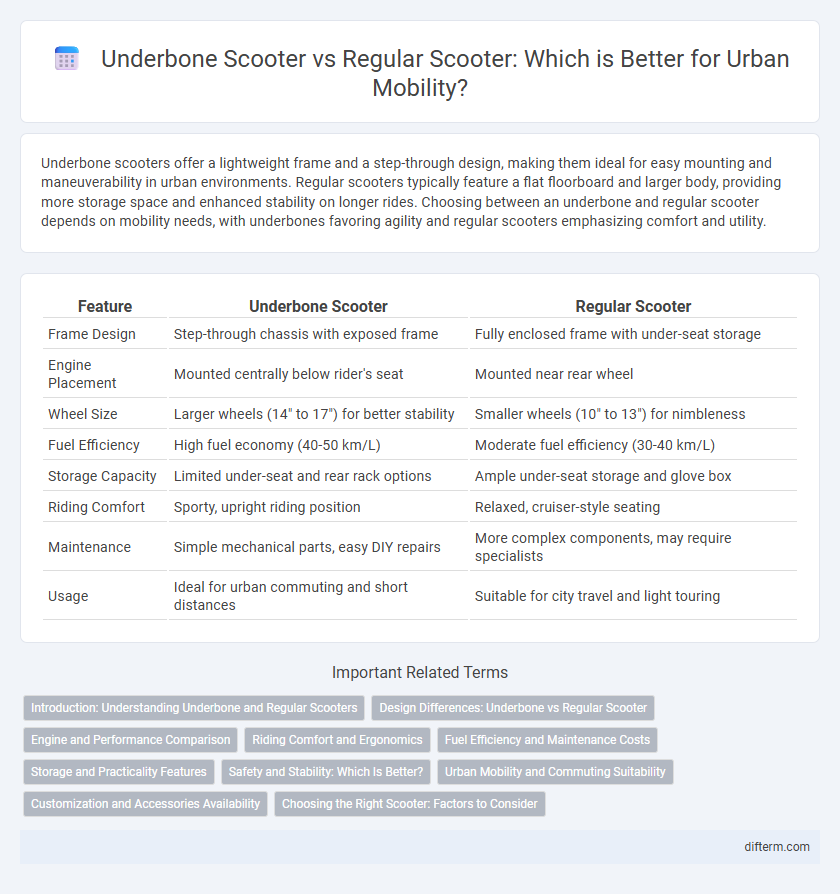Underbone scooters offer a lightweight frame and a step-through design, making them ideal for easy mounting and maneuverability in urban environments. Regular scooters typically feature a flat floorboard and larger body, providing more storage space and enhanced stability on longer rides. Choosing between an underbone and regular scooter depends on mobility needs, with underbones favoring agility and regular scooters emphasizing comfort and utility.
Table of Comparison
| Feature | Underbone Scooter | Regular Scooter |
|---|---|---|
| Frame Design | Step-through chassis with exposed frame | Fully enclosed frame with under-seat storage |
| Engine Placement | Mounted centrally below rider's seat | Mounted near rear wheel |
| Wheel Size | Larger wheels (14" to 17") for better stability | Smaller wheels (10" to 13") for nimbleness |
| Fuel Efficiency | High fuel economy (40-50 km/L) | Moderate fuel efficiency (30-40 km/L) |
| Storage Capacity | Limited under-seat and rear rack options | Ample under-seat storage and glove box |
| Riding Comfort | Sporty, upright riding position | Relaxed, cruiser-style seating |
| Maintenance | Simple mechanical parts, easy DIY repairs | More complex components, may require specialists |
| Usage | Ideal for urban commuting and short distances | Suitable for city travel and light touring |
Introduction: Understanding Underbone and Regular Scooters
Underbone scooters feature a step-through frame with a visible chassis structure, offering lightweight maneuverability and ease of mounting, making them popular in Southeast Asia. Regular scooters typically have a fully enclosed body with a flat floorboard, designed for urban commuting and enhanced rider comfort. Both types vary in engine displacement, fuel efficiency, and storage capacity, catering to different mobility needs and riding styles.
Design Differences: Underbone vs Regular Scooter
Underbone scooters feature a step-through frame with an exposed chassis, providing easier mounting and a lower center of gravity for enhanced stability. Regular scooters typically have a fully enclosed body with a flat floorboard, offering more integrated storage and a streamlined appearance. These design variations affect riding comfort, maneuverability, and storage capacity, catering to different urban commuting needs.
Engine and Performance Comparison
Underbone scooters typically feature smaller engine displacements ranging from 100cc to 125cc, optimized for fuel efficiency and city commuting, while regular scooters often offer larger engines up to 150cc or more for enhanced power and higher top speeds. The underbone design allows better cooling and simpler maintenance, contributing to reliable performance, whereas regular scooters provide smoother acceleration and greater torque through continuously variable transmissions (CVT). Performance metrics show underbone scooters excel in maneuverability and fuel economy, contrasting with regular scooters that deliver superior acceleration and comfort on longer rides.
Riding Comfort and Ergonomics
Underbone scooters feature a step-through frame and compact design that enhances rider agility and ease of mount, promoting comfortable upright seating ideal for urban commuting. Regular scooters offer a wider boot space and often incorporate adjustable handlebars and seating, allowing for customizable ergonomics that suit longer rides. Both vehicle types prioritize rider comfort, but underbone models excel in maneuverability, while regular scooters provide better support for extended journeys.
Fuel Efficiency and Maintenance Costs
Underbone scooters typically offer better fuel efficiency compared to regular scooters due to their smaller engine displacement and lighter frame, making them ideal for urban commuting. Maintenance costs for underbone scooters are generally lower because of simpler mechanical components and easier access to parts. Regular scooters, while often providing more power and comfort, tend to have higher fuel consumption and increased maintenance expenses over time.
Storage and Practicality Features
Underbone scooters typically offer less storage space compared to regular scooters due to their compact frame and under-fuel tank design, which limits under-seat compartment size. Regular scooters usually feature larger storage compartments beneath the seat, accommodating full-face helmets and additional groceries or bags, enhancing daily practicality. Key practical advantages of regular scooters include integrated glove boxes, mounting points for extra storage accessories, and often a more stable platform for carrying heavier loads.
Safety and Stability: Which Is Better?
Underbone scooters typically offer superior stability due to their low center of gravity and reinforced frame design, making them safer for urban commuting. Regular scooters, while often lighter and more maneuverable, may sacrifice stability at higher speeds or on uneven surfaces. Safety features such as ABS brakes and enhanced suspension systems are increasingly standard in both types, but underbone models generally provide more robust handling in challenging road conditions.
Urban Mobility and Commuting Suitability
Underbone scooters offer superior urban mobility due to their lightweight frame and compact design, making them ideal for navigating congested city streets and tight parking spaces. Regular scooters provide greater comfort and storage capacity, which enhances commuting suitability for longer distances and carrying personal items. Both types balance fuel efficiency and ease of use, but underbone models excel in quick maneuverability, while regular scooters deliver more stability and ride comfort in urban traffic.
Customization and Accessories Availability
Underbone scooters offer extensive customization options with aftermarket parts like performance exhausts, brightly colored panels, and tailored storage compartments that appeal to enthusiasts seeking personalization. Regular scooters provide a broader range of factory-approved accessories, including windshields, phone mounts, and enhanced seating for comfort and utility. The thriving aftermarket communities for both scooter types ensure a steady supply of customization parts, but underbone scooters generally support a sportier aesthetic while regular scooters emphasize practicality.
Choosing the Right Scooter: Factors to Consider
When choosing between an underbone scooter and a regular scooter, prioritize factors such as engine size, fuel efficiency, and urban maneuverability. Underbone scooters typically offer a more compact frame and better fuel economy, making them ideal for congested city commutes, while regular scooters provide more storage space and comfort for longer rides. Consider your daily travel distance, parking availability, and maintenance costs to select the scooter that best fits your mobility needs.
underbone scooter vs regular scooter Infographic

 difterm.com
difterm.com